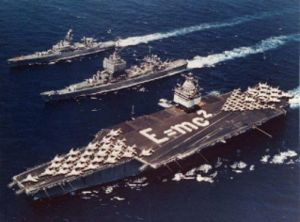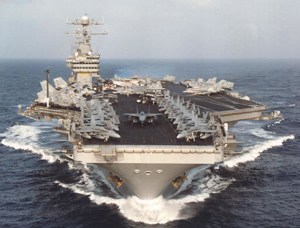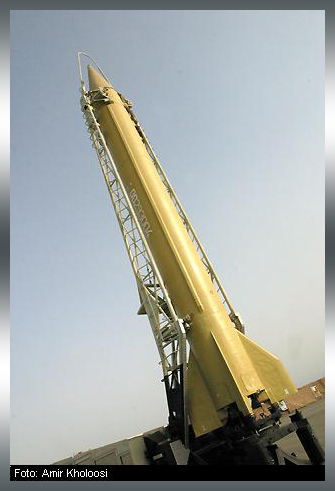|
The World is at
the crossroads of the most serious crisis in
modern history. The US has embarked on a military
adventure, "a long war", which threatens the future of
humanity.
This article documents recent
developments, focusing on military deployment and preparations
in the event of a US led war on Iran. This text follows a number
of earlier reports published by Global Research pertaining to
the War on Iran (See
Iran dossier,
Nuclear War dossier,
Lebanon dossier )

Background
The entire Middle East Central Asian region is on
a war footing.
US-NATO naval deployment is
taking place in two distinct theaters: the Persian Gulf and the
Eastern Mediterranean. (See
Mahdi Darius Nazemroaya, October 2006).
The naval armada in the
Persian Gulf is largely under US command, with the participation
of Canada. Both the USS Enterprise and Eisenhower Strike groups
have been dispatched to the Persian Gulf in a a massive display
of US military might.

USS Enterprise Strike Group |
|
|
|

| |
USS
Eisenhower |
|
|
|
|
The militarization of the
Eastern Mediterranean (on land and sea) is under the control of
several NATO member countries including France, Germany and
Turkey. This military build-up is conducted under the
façade of a UN peace-keeping mission (UNIFIL) pursuant to
UN Security Council Resolution 1701.
In this context, the war on Lebanon must be viewed as a stage of
the broader US sponsored military road-map, which targets
Syria.
In September, Germany dispatched a fleet of eight ships
including 2 frigates, with up to 2,400 personnel aboard. The
German navy will be in charge of the multinational naval force,
which has, under its official UNIFIL mandate "to prevent arms
shipments to Hezbollah". The German naval force will operate out
of the Cyprus port of Limassol, located within less than 100 km.
from the Lebanon-Syria coastline. The Cyprus based multinational
naval force could eventually be used to encroach on maritime
trade with Syria.
In early October, Turkey
dispatched several warships, which will join the multinational
naval force under German command. While Turkey is formally part
of the UN international force (UNIFIL), it is also a close
military ally of Israel. Greek, Bulgarian and Italian warships
have also been dispatched to the Lebanese coast.
France has dispatched armored vehicle and infantry units. (Chars
Leclerc see below).
The nature of the military equiipment and weapons systems being
deployed has little to do with "peace-keeping". Moreover,
NATO established a close military partnership with Israel in
2005, which in practice binds NATO member countries involved in
Lebanon to fully cooperate with Israel.
German Brandenburg Class Frigate dispatched
to Lebanese Coast
|
|
|
French
Armored Vehicles (Chars Leclerc) en route to Lebanon.
The Leclerc armored vehicles were used in Kosovo in
1999 |
|
The naval
buildup has been coordinated with the planned air attacks on
Iran. The latter were outlined in mid-2004, following the
formulation of CONCEPT PLAN CONPLAN 8022 (early 2004). The air
attacks on Iran would involve a "shock and awe" blitzkrieg
on a scale similar to the 2003 air war on Iraq.
In November
2004, US Strategic Command conducted a major exercise of a
"global strike plan" entitled "Global Lightening". The latter
involved a simulated attack using both conventional and nuclear
weapons against a "fictitious enemy" [Iran]. Following the
"Global Lightening" exercise, US Strategic Command declared an
advanced state of readiness.
CONPLAN is the
operational plan pursuant to the Global Strike Plan. It is
described as "an actual plan that the Navy and the Air Force
translate into strike package for their submarines and
bombers,'
CONPLAN 8022
is 'the overall umbrella plan for sort of the pre-planned
strategic scenarios involving nuclear weapons.'
'It's
specifically focused on these new types of threats -- Iran,
North Korea -- proliferators and potentially terrorists too,'
he said. 'There's nothing that says that they can't use
CONPLAN 8022 in limited scenarios against Russian and Chinese
targets.' (According to Hans Kristensen, of the
Nuclear Information Project,
quoted in Japanese economic News Wire, op cit)
The use of
tactical nuclear weapons is contemplated under CONPLAN 8022
alongside conventional weapons, as part of the Bush
administration's preemptive war doctrine. In May 2004, National
Security Presidential Directive
NSPD 35 entitled Nuclear Weapons Deployment Authorization
was issued. While its contents
remains classified, the presumption is that NSPD 35 pertains to
the deployment of tactical nuclear weapons in the Middle East
war theater in compliance with CONPLAN 8022.
(For further
details on the US nuclear option, see Michel Chossudovsky,
Nuclear War against Iran, January 2006,
The Dangers of a Middle East Nuclear War, February 2006,
Is the Bush Administration Planning a Nuclear Holocaust ,
February 2006)
War
Preparations
Iran is in an
advanced stage of readiness in the eventuality of a US attack.
In response to
the US-NATO sponsored military build-up, Iran has conducted
extensive war games throughout its territory. (See
Mahdi Darius Nazemroaya, 21 August 2006)
|
|
|
Iran
War Games, August 2006. |
|
|
 Iran
War Games, August 2006. Iran
War Games, August 2006. |
|
Moreover,
barely acknowledged by the Western media, both China and Russia
have conducted war games in Central Asia, in collaboration with
their coalition partners. In late September, Russia conducted
air war exercises over a large part of its territory, extending
from the Volga to the frontiers of Alaska and North America.
These war games prompted the scrambling of NORAD fighter
planes.
Military
exercises involving the participation of Russia, Kazakhstan,
Kyrgyzstan and Tajikistan under the Collective Security Treaty
Organization, (CSTO) were launched in August. These war games,
officially described as part of a " counter terrorism program",
were held barely a week before those conducted by the Iranian
military. (See
Michel Chossudovsky, 24 August 2006)
Broadly
coinciding with both the Iranian and CSTO military exercises,
China and Kazakhstan also conducted military exercises in August
under the auspices of the
Shanghai Cooperation Organization (SCO). Iran
is an observer member in the SCO. (For Timeline of War
Games see Table below)
|
|
|
Observer States including Iran are indicated in Green
Members of the Shanghai Cooperation Organization (SCO).
|
|
In late
September, China and Tajikistan held a joint military exercise,
code-named "Cooperation-2006", according to a memorandum of
understanding signed between the two governments. Tajikistan has
a 500 km. border with Afghanistan. These war games directly
address US-NATO military presence in neighboring Afghanistan.
In early
October, in the latest round of Central Asian war games under
CSTO auspices, joint Russian-Kyrgyz war exercises were held
(starting on October 2nd) at Russia's Kant airbase located some
30 km. from the Kyrgyz capital. Officially described as an
"anti-terror drill", these high profile exercises involved the
deployment of Russian and Kyrgyz special forces units. Russia's
top brass and defense minister Sergei Ivanov were in attendance
for the launching of the event:
"About 350
servicemen from special forces units, combat vehicles,
artillery, Su-25 Frogfoot ground support aircraft and Mi-8 Hip
multipurpose helicopters are participating in the active phase
of the maneuvers, which include the firing of live ammunition
at the Osh practice range.
Russian
Defense Minister Sergei Ivanov, who is currently on a visit to
the Central Asian state, Kyrgyzstan Prime Minister Felix Kulov
and Defense Minister Ismail Isakov are attending the
exercises.
Russia and
Kyrgyzstan are both members of the Collective Security Treaty
Organization, a post-Soviet security grouping that also
includes Armenia, Belarus, Kazakhstan and Tajikistan. They are
also in the Shanghai Cooperation Organization, a regional
security body in Central Asia that includes China, Uzbekistan,
Kazakhstan and Tajikistan." (Novosti
5 0ctober 2006)
|
 |
| Russian Su-25 Frogfoot ground
support aircraft in Russia-Kyrgyz war exercises |
|
|
Meanwhile, in
late September, Russia also conducted military exercises in
Dagestan, involving the 136th Brigade. The exercise held at
the Buynakskiy training ground involved an unnamed "foreign
State" which was attacking Russia. According to one Russian
press report: "Given the scale [of the simulated enemy
attack], this can be compared with WWII. The [unnamed] enemy
is artful, well armed and well trained."
Also in early
October, Belarus and Russia announced that they will be hold
training sessions for the two countries' command and control
bodies, with a view to coordinating their military activities.
(Belarus TV, October 1, 2006)
Consistent Pattern
The overall
significance of these military drills must be assessed in
relation to the sequence of Russian, Chinese and Iran war
exercises conducted since late August.
There is a
consistent pattern. These war games are not isolated events.
They are part of a carefully coordinated endeavor, in response
to the US-NATO military build-up. They should also be
considered as acts of deterrence, intended to display
military capabilities to deter military action by the US led
coaltion.
The issue of
war preparation has been carefully avoided by the Western
media. The sequence and interrelationship between these war
games is not mentioned.
While the war
exercises are casually acknowledged in separate wire service
reports, the Western media fails to address the broader
implications of these military exercises.
Military
Alliances
The SCO and
CSTO war games must also be examined in relation to the
structure of military alliances. Both China and Russia are
allies of Iran, involved in extensive military cooperation
agreements.
China and
Russia are major actors in Central Asian oil. They have
significant strategic and economic interests in the Central
Asian region and in the Caspian sea basin. They also have
economic cooperation agreements with Iran's State oil
company.
US
Sponsored Military Build-Up
The Cold War
although officially over has not quite reached its climax.
The US
military agenda is not limited to gaining control over Iran's
oil and gas reserves, (using the "campaign against
international terrorism" as a pretext). Reminiscent of
the Cold war era, the objective of US military intervention
also consists in weakening and ultimately displacing China and
Russia from playing a significant role in Central Asia.
Most Western
press reports have failed to acknowledge the seriousness of
the US-NATO- Israeli military build-up. Underlying what is
normally understood as a Middle East war, the conflict could
evolve towards a clash between former competing super powers
of the Cold War era.
Directed
against Iran and Syria, the US sponsored military operation,
if it were to be launched, could result in a broader conflict
marked by the indirect involvement of Russia and China and
their central Asian allies. In fact that indirect involvement
is already established through Iran's observer status to the
SCO, various bilateral military cooperation agreements as well
as the sale of Chinese and Russian weapons systems to Iran.
The US
is involved in covert operations throughout Central Asia with
a view to essentially displacing Russia. The tensions in
Armenia, Azerbaijan and Georgia are the direct result of US
geopolitical encroachments within what used to be within
Moscow's traditional sphere of influence. Georgia and
Azerbaijan have become de facto US protectorates.
In the
recent showdown between Russia and Georgia, Georgian President
Mikhail Saakashvili "pledged to continue Georgia's
efforts to join NATO as well as secure the speedy withdrawal
of Russian forces from Georgian territory.
Moscow
responded by putting Russian forces inside Georgia on high
alert, following the accusation by Tbilisi that Russian
military officers inside Georgia were involved in spying. The
withdrawal of Russian troops from Georgia opens the way for
the stationing of NATO forces, which are already present in
neighbouring Azerbaijan.
Meanwhile, in
relation to the issue of NATO enlargement, Moscow warned the
Atlantic Alliance in early October that it would take
"appropriate measures" if Poland were to deploy "elements of
the missile defense systems of the United States or NATO on
its territory", (Interfax News Agency, 4 Oct 2006)
“We
continue to treat these plans critically. Our opinion is
that [these plans] along with the possible deployment of
NATO’s European missile defense system can produce a
negative effect on strategic stability, security in the
region and relations between the states,” Kamynin said. “A
new situation like this one will objectively require us to
take appropriate measures because we cannot rely in such
matters solely on statements that the missile defense
systems of the U.S. and NATO in Europe ’are not aimed’
against Russia,” the official added."(Ibid)
Known and
documented, China is also supporting Iran in the development
of its air defense system. Moreover, according to a
report in the Daily Telegraph (5 October 2006),
Washington has acknowledged that
China has been involved in
"secretly
fired powerful laser weapons designed to disable American
spy satellites by "blinding" their sensitive surveillance
devices, it was reported yesterday.
The
hitherto unreported attacks have been kept secret by the
Bush administration for fear that it would damage attempts
to co-opt China in diplomatic offensives against North Korea
and Iran.
Sources
told the military affairs publication Defense News that
there had been a fierce internal battle within Washington
over whether to make the attacks public. In the end, the
Pentagon's annual assessment of the growing Chinese military
build-up barely mentioned the threat. (Daily Telegraph, 5
October 2006)
"Cold War
Shivers"
In addition
to the various CSTO and SCO war games carried out in Central
Asia in the course of the last two months, Russia's air force
also conducted a major military exercise in late September,
which extended over a large part of its territory, from the
Volga to the Alaskan border, extending from the Volga military
District to the Far East Military District (see map below).
The war drill involved the dropping of bombs as well as
missile launches against an unnamed "notional enemy":
Long before
dawn, more than ten Tu-160 and Tu-95 cruise missile carriers
of the long-range aviation regiment based in [the town of]
Engels set course for Russia's northern borders. The
aircraft were on the mission to reach the Arctic Ocean and
launch several practice cruise missiles at the Khalmer-Yu
range near Vorkuta. This was the last training sortie from a
military airfield near Saratov. Bombs were dropped and
missiles fired throughout almost the entire Northern
hemisphere.
(...)
[Correspondent] One of the most important and most difficult
phases of the exercise involved bomb dropping at the
Guryanovo training range in Saratov Region. Eight Tu-22
strategic bombers were tasked with destroying an airfield of
the notional enemy. Even from the command centre 10 km away,
the explosions made by 250-kg bombs appeared to be enormous.
(Transcript of Russian TV Report, Channel One TV, Moscow,
Russian 0600 GMT 30 September 2006)

|
|
|
Russia's TU-22
Strategic bomber |
|
In a scenario
reminiscent of the Cold War era, US and Canadian fighter
aircraft intercepted Russian Tu-160 planes off the Alaska
coastline:
U.S. and
Canadian fighter aircraft intercepted Russian planes off the
Alaska coast, but it was not considered a hostile incident,
the North American Aerospace Defense Command said on Friday.
NORAD said
the aircraft never violated U.S. or Canadian airspace... But
fighters were launched because the Russians had entered a zone
around North America in which NORAD considers uninvited
aircraft to be potential threatening.
The Tu-95 Bear heavy bombers
had been participating in an annual Russian air force exercise
near the coast of Alaska and Canada, NORAD said. It did not
specify how many Russian planes were involved. (Reuters, 2
October 2006)
|
|
|
Russian
TU 160 cruise missile carrier |
|
|
|
Russian
TU-95 Bear Bomber |
Both Russian
and Western press reports dismissed these major air exercises as
routine, without examining the broader framework and sequence of
Russian sponsored war games.
A NORAD
spokesperson stated that while they did not consider the Russian
war games as "hostile", they, nonetheless wanted the
Russians to know that "NORAD
is alive and well":
"This wasn't
treated as a hostile. It was just being vigilant and letting
them know that NORAD is alive and well," said Canadian Air
Force Capt. Jennifer Faubert, a spokeswoman for NORAD's
Canadian Region. (Reuters, 2 October 2006)
Beyond the
scope of a Middle East war, the broader US military agenda,
which includes the strategic defense initiative, threatens
global security. The various war games conducted by Iran, Russia
and China are not only intended to prepare for war, they are
also a demonstration of military capabilities in response to a
potential aggressor. They are also intended to act as a
deterrent.
Reversing
the Tide of War
The World is at
the crossroads of the most serious crisis in modern history. The
US has embarked on a military adventure, "a long war",
which threatens the future of humanity.
This article
has attempted to document the various preparations for war.
While there a
number of factors which may prevent this war from
occurring, including divisions within the US adminstration and
military, behind the scenes negotiations with
China, Russia, Iran, etc., the risk of an extended Middle East
-Central Asian war must be forcefully addressed.
The devastation and loss of life which could result from this
proposed military agenda would be incalculable, particularly if
the conflict escalates to the broader region.
The possible use of tactical nuclear weapons by the US,
ironically in retaliation for Iran's non-compliance to suspend
uranium enrichment (in its civilian nuclear energy program)
raises the specter of a a nuclear nightmare.
The economic
disruptions resulting from a broader Middle East war would not
be limited to spiraling oil prices, following a blockade of the
Straits of Hormuz.
The energy crisis would immediately backlash on freight prices
and costs of production in virtually all sectors of economic
activity. It would also contribute to disrupting financial
markets Worldwide.
Moreover, if China were to become involved in the conflict, the
large scale commodity trade in manufactured products out of
China, which supplies Western markets with vast array of
consumer goods, would be disrupted.
The issue is not whether the war will or will not take place but
what are the instruments
at our disposal which will enable us to shunt and ultimately
disarm this global military agenda.
In the weeks
and months ahead, it is essential that citizens'
movements around the world act consistently to confront their
respective governments and reverse and dismantle this military
agenda.
Dismantling the
network of war propaganda is essential. This war can not
conducted without the support of the corporate media, which
ultimately upholds the US led war against Iran.
What is needed
is to break the
conspiracy of silence,
expose the media lies
and distortions, confront the criminal nature of the
US Administration and of those governments which support it, its
war agenda as well as its so-called "Homeland Security agenda"
which has already defined the contours of a police State.
It is essential
to bring the US war project to the forefront of political
debate, particularly in North America and Western Europe.
Political and military leaders who are opposed to the war must
take a firm stance, from within their respective institutions.
Citizens must take a stance individually and collectively
against war.
War criminals
occupy positions of authority. The citizenry is galvanized into
supporting the rulers, who are "committed to their safety and
well-being". Through media disinformation, war is given a
humanitarian mandate.
The legitimacy
of the war must be addressed. Antiwar sentiment alone does not
disarm a military agenda. High ranking officials of the Bush
administration, members of the military and the US Congress have
been granted the authority to uphold an illegal war.
The corporate backers and sponsors of war and war crimes must
also be targeted including the oil companies, the defense
contractors, the financial institutions and the corporate media,
which has become an integral part of the war propaganda machine.
1. The role
of media disinformation in sustaining the military agenda is
crucial.
We will not succeed in our endeavors unless the propaganda
apparatus is weakened and eventually dismantled. It is essential
to inform our fellow citizens on the causes and consequences of
the US-led war, not to mention the extensive war crimes and
atrocities which are routinely obfuscated by the media. This is
no easy task. It requires an effective
counter-propaganda program which refutes mainstream media
assertions.
It is essential that the relevant information and analysis
reaches the broader public. The Western media is
controlled by a handful of powerful business syndicates. The
media conglomerates which control network TV and the printed
press must be challenged through cohesive actions which reveal
the lies and falsehoods.
2. There is opposition within the political
establishment in the US as well as within the ranks of the Armed
Forces.
While this opposition does not necessarily question to overall
direction of US foreign policy, it is firmly opposed to military
adventurism, including the use of nuclear weapons. These voices
within the institutions of the State, the Military and the
business establishment are important because they can be
usefully channeled to discredit and ultimately dismantle the
"war on terrorism" consensus. The broadest possible
alliance of political and social forces is, therefore, required
to prevent a military adventure which in a very real sense
threatens the future of humanity.
3. The
structure of military alliances must be addressed. A timely
shift in military alliances could potentially reverse the course
of history.
Whereas France and Germany are broadly supportive of the US led
war, there are strong voices in both countries as well as within
the European Union, which firmly oppose the US led military
agenda, both at the grassroots level as well within the
political system itself.
It is essential that the commitments made by European heads of
government and heads of State to Washington be cancelled or
nullified, through pressure exerted at the appropriate political
levels. This applies, in particular, to the unbending support of
the Bush administration, expressed by President Jacques Chirac
and Chancellor Angela Merkel.
The weakening of the system of alliances which commits Western
Europe to supporting the Anglo-American military axis, could
indeed contribute to reversing the tide. Washington would
hesitate to wage a war on Iran without the support of France and
Germany.
4. The holding
of large antiwar rallies is important and essential. But in will
not in itself reverse the tide of war unless it is accompanied
by the development of a cohesive antiwar network.
What is required is a grass roots antiwar network, a mass
movement at national and international levels, which challenges
the legitimacy of the main military and political actors, as
well as their corporate sponsors, and which would ultimately be
instrumental in unseating those who rule in our name. The
construction of this type of network will take time to develop.
Initially, it should focus on developing an antiwar stance
within existing citizens' organizations (e.g. trade unions,
community organizations, professional regroupings, student
federations, municipal councils, etc.).
5. 9/11
plays a crucial and central role in the propaganda campaign.
The threat of an Al
Qaeda "Attack on America" is being used profusely by the Bush
administration and its indefectible British ally to galvanize
public opinion in support of a global military agenda.
Known and documented, the
"Islamic terror network" is a creation of the US intelligence
apparatus. Several of the terror alerts were based on fake
intelligence as revealed in the recent
foiled "liquid bomb attack". There
is evidence that the several of the terrorist "mass casualty
events" which have resulted in civilian casualties were
triggered by the military and/or intelligence services. (e.g
Bali 2002).

The "war on terrorism" is
bogus.
The 911 narrative as conveyed by
the 911 Commission report is fabricated.
The Bush administration is involved in
acts of cover-up
and complicity at the highest levels of government.

Revealing the lies behind 911 would
serve to undermine the legitimacy of the "war on terrorism"
which constitutes the main justification for waging war in the
Middle East.

Without 911, the war criminals in high
office do not have a leg to stand on. The entire national
security construct collapses like a deck of cards.

TABLE
TIMELINE OF WAR GAMES
(IRAN, RUSSIA, CHINA AND THEIR COALITION PARTNERS) (August
-October 2006)
19 August 2006-- Iran:
Zarbat-e Zolfaqar military exercises, in major regions of
the country. These war games were slated to continue until
late September.
24- 29 August: Russia,
Kazakhstan, Kyrgyzstan and Tajikistan, Uzbekistan (observer
status) under the Collective
Security Treaty Organization, (CSTO) The Rubezh-2006
exercise at the Kazak port city of Aktau .
24 August: China and
Kazakhstan held under SCO
auspices. Held simultaneously and in liaison with the CSTO
war exercise in Kazakhstan.
22- 24 September: China
and Tajikistan: first joint
military exercise, code-named "Cooperation-2006".
27 September:
Iran. Amphibious war game named
Payambar-e A'zam [Great Prophet] staged in Esfahan. A number
of battalions belonging to Brigade 1 of Imam Husayn Division
14 staged the Payambar-e A'zam war game in the Zayandeh
River.
30 September: Russian
Long Range Air War Games out of
the Saratov Air Base, extending to the Far East, the Artic
and the Russia-Alaska border. These war games prompted the
scrambling of NORAD fighter planes.
30 September: Russia,
Dagestan war games involving the
136th brigade, held at the Buynakskiy training ground
2 October Kyrgyz
war games, Russian and Kyrgyz
Special Forces.
4 October Russian
Navy Exercises in the Black Sea
near Georgia's coastline, in response to recent events in
Georgia and following an economic embargo on Georgia imposed
by Russia.
Sources: Press reports and wire
services.


Note: Readers are
welcome to cross-post this article with a view to spreading the
word and warning people of the dangers of a broader Middle East
war. Please indicate the source and copyright note.
media inquiries
crgeditor@yahoo.com

ANNEX:
MAP: Russian Federation: Military
Districts (MD)
| |
|
MAP: Russian
Federation: Military Districts (MD)
|
|

MAP:
MIDDLE EAST THEATER OF WAR
THE BATTLE FOR OIL
|
Eric Waddell, Global Research 2003 |

|
Global
Research Articles by Michel Chossudovsky |
To become a
Member of Global Research
The CRG grants permission to cross-post original Global
Research articles on community internet sites as long as the
text & title are not modified. The source and the author's
copyright must be displayed. For publication of Global
Research articles in print or other forms including
commercial internet sites, contact:
crgeditor@yahoo.com
www.globalresearch.ca contains copyrighted
material the use of which has not always been specifically
authorized by the copyright owner. We are making such
material available to our readers under the provisions of
"fair use" in an effort to advance a better understanding of
political, economic and social issues. The material on this
site is distributed without profit to those who have
expressed a prior interest in receiving it for research and
educational purposes. If you wish to use copyrighted
material for purposes other than "fair use" you must request
permission from the copyright owner.
For media inquiries:
crgeditor@yahoo.com
© Copyright Michel Chossudovsky, Global Research, 2007
|
Privacy Policy
© Copyright 2005-2007 GlobalResearch.ca
Web site engine by
Polygraphx
Multimedia © Copyright 2005-2007
END GLOBAL RESEARCH ARTICLE





| |
| The Truth about
Cluster Bombs - The people who make them and use
them. |
|
|
|